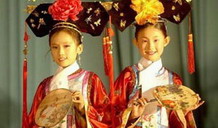Rock Paintings of Yinshan Mountain

The rock paintings of Yinshan Mountain can be divided into groups of four ages and five periods:
Paintings of the first age are the works of primitive clan tribes of the period from the late Paleolithic Age to the mid Bronze Age. Rock paintings in this period were in a period of prosperity with their large numbers, wide distributions and delicate craftsmanship.
The rock paintings of the second age are those drawn by the Huns during the period from the Spring and Autumn Period (770-476 B.C.) to the Western and Eastern Han dynasties (206 B.C.-220 A.D.).
The third age mainly refers to the rock paintings of the Turk style, equivalently from the Northern Dynasty (386-581) to the Tang Dynasty (618-907).
Rock paintings of the fourth age are mainly works of the Mongolians after the Yuan Dynasty (1271-1368). The colored rock paintings are unique to the Mongolians. Apart from some themes of the life and production activities (for example, galloping horses, two-humped camels, herdsman, etc.), most of the paintings are designs related to Lamaism.
The rock paintings of Yinshan Mountain were drawn mostly by either chiseling or grinding. They are plain and vivid in their artistic features and are mostly based on realistic depictions and presenting a record of the social life of the early historical stages of human beings.






